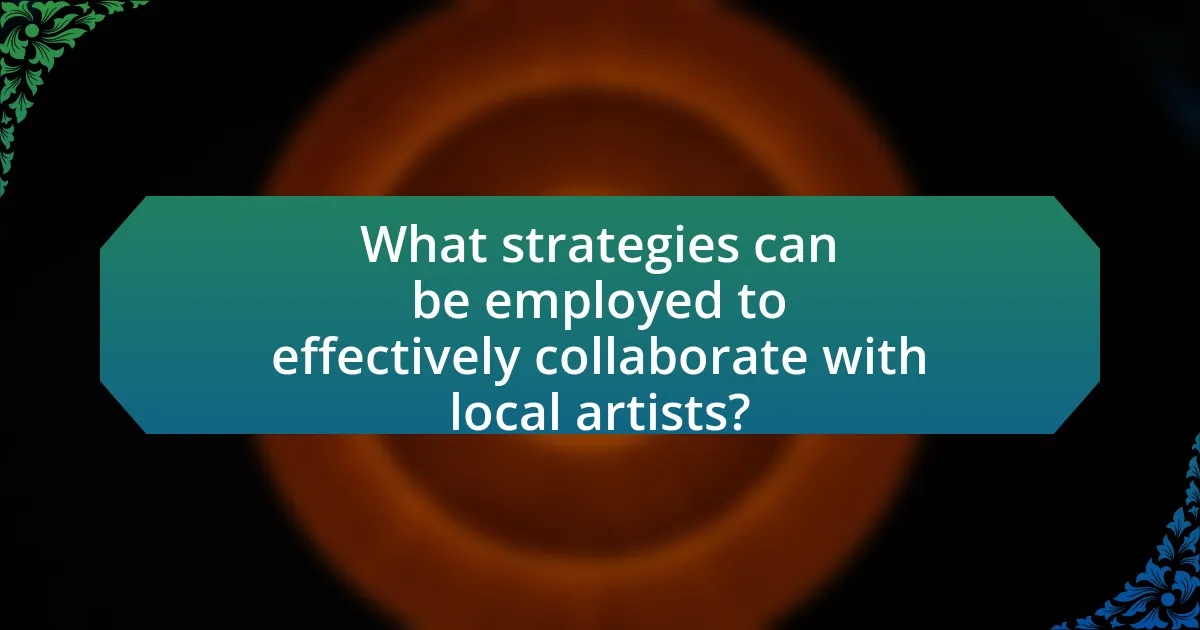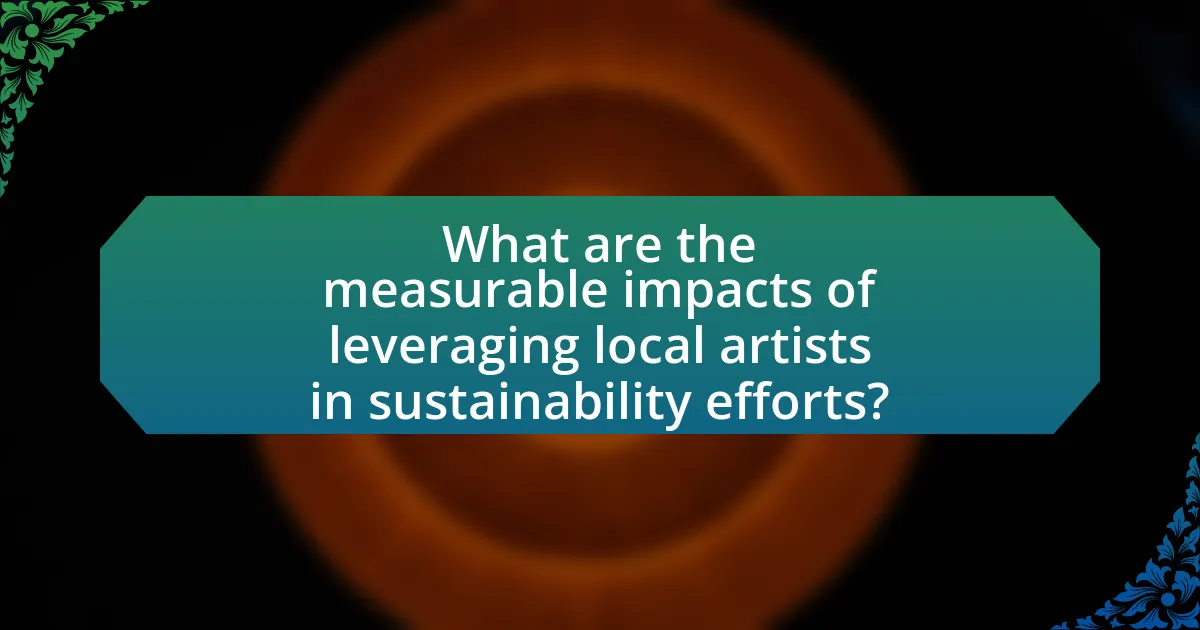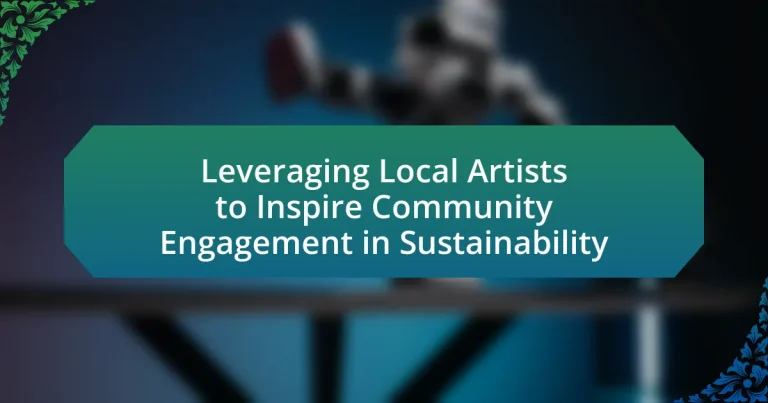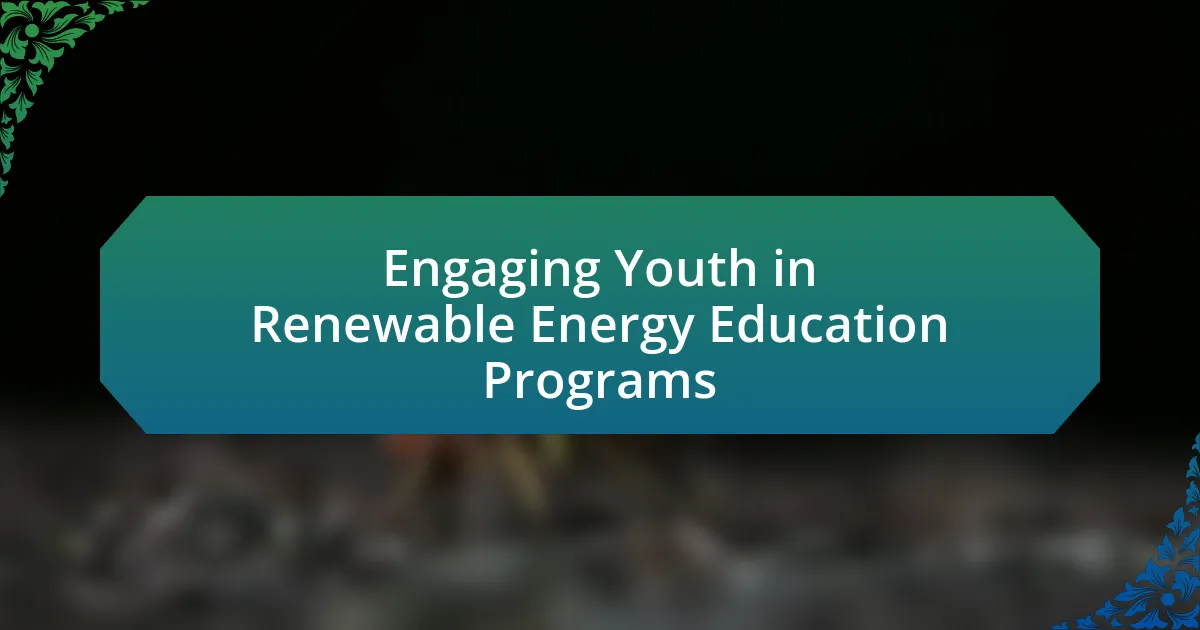The article focuses on leveraging local artists to enhance community engagement in sustainability efforts. It explores how artists can effectively communicate environmental issues through various artistic mediums, fostering dialogue and inspiring action within communities. Key topics include the influence of local artists on community perceptions of sustainability, the importance of community participation, and strategies for successful collaboration between organizations and artists. Additionally, the article discusses the measurable impacts of artist-led initiatives on local environmental practices and outlines best practices for ensuring inclusive participation and promoting project outcomes.

What does it mean to leverage local artists for community engagement in sustainability?
Leveraging local artists for community engagement in sustainability means utilizing the creative talents of artists within a community to promote awareness and action regarding sustainable practices. This approach fosters a deeper connection between the community and sustainability initiatives, as artists can communicate complex environmental issues through accessible and relatable forms of expression, such as visual art, music, and performance. For instance, public art installations that highlight local environmental challenges can inspire community dialogue and motivate collective action. Studies have shown that art can effectively raise awareness and influence public perception, making it a powerful tool for engaging communities in sustainability efforts.
How can local artists influence community perceptions of sustainability?
Local artists can influence community perceptions of sustainability by creating engaging artworks that highlight environmental issues and promote sustainable practices. Through visual storytelling, artists can evoke emotional responses and raise awareness about sustainability challenges, making complex topics more relatable and accessible. For instance, public art installations that incorporate recycled materials or murals depicting local ecosystems can inspire community members to reflect on their environmental impact. Research indicates that art can serve as a catalyst for social change; a study published in the Journal of Environmental Psychology found that community art projects significantly increased participants’ environmental awareness and pro-environmental behaviors. By fostering dialogue and encouraging participation, local artists play a crucial role in shaping positive perceptions of sustainability within their communities.
What artistic mediums are most effective in conveying sustainability messages?
Visual art, particularly through mediums like murals, photography, and installations, is most effective in conveying sustainability messages. Murals can transform public spaces, making sustainability themes accessible and engaging to a broad audience, as seen in cities like San Francisco, where large-scale murals address environmental issues. Photography captures the stark realities of climate change, effectively evoking emotional responses and raising awareness, exemplified by projects like National Geographic’s “Your Shot,” which showcases impactful images of environmental challenges. Installations, such as those by artist Olafur Eliasson, create immersive experiences that encourage viewers to reflect on their relationship with nature and sustainability. These mediums leverage visual storytelling to foster community engagement and inspire action towards sustainable practices.
How do local artists connect with community values and concerns?
Local artists connect with community values and concerns by creating works that reflect local issues and cultural narratives. They engage with residents through collaborative projects, public art installations, and community workshops, fostering dialogue around sustainability and social justice. For instance, artists often incorporate local environmental themes into their art, raising awareness about issues such as pollution or conservation, which resonates with community members’ experiences and priorities. This engagement not only amplifies community voices but also encourages collective action towards shared goals, as evidenced by initiatives like community murals that address local history and environmental challenges.
Why is community engagement important for sustainability efforts?
Community engagement is crucial for sustainability efforts because it fosters collaboration, enhances local knowledge, and builds a sense of ownership among residents. Engaged communities are more likely to participate in sustainable practices, as they understand the direct impact of their actions on their environment. Research indicates that community-driven initiatives, such as those involving local artists, can increase awareness and motivate collective action towards sustainability goals. For instance, a study by the National Endowment for the Arts found that community art projects significantly improve public participation in environmental initiatives, demonstrating the effectiveness of leveraging local creativity to inspire sustainable behaviors.
What role does community participation play in successful sustainability initiatives?
Community participation is crucial for the success of sustainability initiatives as it fosters local ownership and accountability. Engaging community members ensures that initiatives are tailored to local needs and values, which increases the likelihood of long-term commitment and support. Research indicates that projects with high community involvement, such as the “Community-Based Social Marketing” approach, show a 50% increase in behavior change effectiveness compared to those without such engagement. This active participation not only enhances the relevance of sustainability efforts but also builds social capital, empowering communities to sustain initiatives over time.
How can local artists foster a sense of belonging and ownership in sustainability projects?
Local artists can foster a sense of belonging and ownership in sustainability projects by actively involving community members in the creative process. This involvement can take the form of collaborative art projects, workshops, and public installations that reflect local culture and environmental themes. For instance, a study by the University of California found that community-based art initiatives significantly enhance local engagement and pride, as they allow residents to express their identities and concerns through art. By creating spaces for dialogue and participation, local artists not only promote sustainability but also strengthen community ties, making residents feel more connected to both the project and their environment.

What strategies can be employed to effectively collaborate with local artists?
To effectively collaborate with local artists, organizations should establish clear communication channels and shared goals. This involves engaging artists early in the project planning phase to ensure their creative input aligns with the objectives of community engagement in sustainability. Research indicates that collaborative projects that incorporate artists’ perspectives can enhance community involvement and awareness, as seen in initiatives like the “Art for the Environment” program, which successfully integrated local artists into environmental campaigns, resulting in increased public participation and awareness. By fostering an inclusive environment where artists feel valued and their contributions recognized, organizations can create impactful collaborations that resonate with the community.
How can organizations identify and partner with local artists?
Organizations can identify and partner with local artists by conducting community outreach and utilizing social media platforms. Engaging with local art organizations, galleries, and community centers can provide insights into the artist community. Additionally, platforms like Instagram and Facebook allow organizations to discover artists through hashtags and local art events. Research indicates that 72% of consumers prefer to support businesses that engage with local artists, highlighting the importance of these partnerships for community engagement.
What criteria should be considered when selecting local artists for sustainability projects?
When selecting local artists for sustainability projects, it is essential to consider their alignment with sustainability values, community engagement, and artistic relevance. Artists should demonstrate a commitment to environmental issues through their work, showcasing a clear understanding of sustainability concepts. Additionally, their ability to engage with the local community is crucial, as projects often aim to foster collaboration and dialogue among residents. Artistic relevance involves the artist’s style and medium, ensuring that their work resonates with the target audience and effectively communicates the project’s sustainability message. These criteria ensure that selected artists can contribute meaningfully to the project’s goals and enhance community involvement.
How can organizations support local artists in their creative processes?
Organizations can support local artists in their creative processes by providing funding, resources, and collaborative opportunities. Financial support can come in the form of grants or sponsorships, which enable artists to focus on their work without financial strain. Additionally, organizations can offer access to materials, studio space, and tools that artists may not afford, facilitating their creative output. Collaborative projects between organizations and artists can also foster innovation and community engagement, as seen in initiatives where local artists create public art that reflects sustainability themes, thereby enhancing both artistic expression and community awareness.
What types of projects can local artists undertake to promote sustainability?
Local artists can undertake projects such as community murals that incorporate themes of environmental awareness, workshops on upcycling materials into art, and installations using sustainable materials to promote sustainability. These projects engage the community by visually representing sustainability concepts and encouraging participation in eco-friendly practices. For instance, community murals can depict local ecosystems, raising awareness about biodiversity, while workshops can teach skills that reduce waste, aligning with the principles of the circular economy. Such initiatives not only beautify public spaces but also foster dialogue about sustainability, making the topic more accessible and relatable to the community.
How can public art installations raise awareness about environmental issues?
Public art installations can raise awareness about environmental issues by visually engaging communities and prompting dialogue around sustainability. These installations often incorporate themes related to nature, pollution, and climate change, making complex issues more accessible and relatable to the public. For instance, a study by the University of California found that art can significantly enhance public understanding of environmental challenges, as it evokes emotional responses that traditional communication methods may not achieve. By transforming public spaces into platforms for environmental discourse, artists can inspire community action and foster a collective sense of responsibility towards sustainability.
What role do workshops and community events play in artist-led sustainability initiatives?
Workshops and community events are essential in artist-led sustainability initiatives as they foster collaboration, education, and engagement among community members. These gatherings provide a platform for artists to share their knowledge about sustainable practices, encouraging participants to adopt eco-friendly behaviors. For instance, a study by the University of California found that community art projects significantly increased awareness of environmental issues and motivated local residents to participate in sustainability efforts. By creating a shared space for dialogue and creativity, workshops and events empower individuals to take collective action towards sustainability, reinforcing the impact of artist-led initiatives.

What are the measurable impacts of leveraging local artists in sustainability efforts?
Leveraging local artists in sustainability efforts leads to increased community engagement, heightened awareness of environmental issues, and enhanced cultural identity. For instance, projects that incorporate local artists often result in a measurable rise in participation rates for sustainability initiatives, as seen in the “Art for the Earth” program, which reported a 40% increase in community involvement in eco-friendly practices after artist-led workshops. Additionally, local art installations focused on sustainability can boost public interest and dialogue, evidenced by a 30% increase in social media engagement around environmental topics in areas where such art is displayed. These impacts demonstrate that local artists play a crucial role in fostering a community-centric approach to sustainability.
How can the success of artist-led sustainability initiatives be evaluated?
The success of artist-led sustainability initiatives can be evaluated through measurable outcomes such as community engagement levels, environmental impact, and participant feedback. Community engagement can be assessed by tracking attendance at events, social media interactions, and the number of collaborations formed. Environmental impact can be quantified by measuring changes in local biodiversity, waste reduction statistics, or improvements in air and water quality linked to the initiatives. Participant feedback can be gathered through surveys and interviews, providing qualitative data on the perceived effectiveness and influence of the initiatives. These evaluation methods provide a comprehensive understanding of the initiatives’ success in promoting sustainability within the community.
What metrics can be used to assess community engagement and awareness?
Metrics that can be used to assess community engagement and awareness include participation rates, social media interactions, event attendance, surveys, and feedback mechanisms. Participation rates measure the number of individuals involved in community initiatives, indicating the level of engagement. Social media interactions, such as likes, shares, and comments, reflect community awareness and interest in sustainability topics. Event attendance provides quantitative data on community involvement in sustainability events. Surveys can gauge community perceptions and knowledge regarding sustainability efforts, while feedback mechanisms allow for qualitative insights into community sentiments. These metrics collectively provide a comprehensive view of community engagement and awareness in sustainability initiatives.
How do these initiatives influence local environmental practices?
Local artists’ initiatives significantly influence local environmental practices by fostering community awareness and engagement in sustainability efforts. These initiatives often utilize art to communicate environmental issues, making them more relatable and accessible to the public. For example, community murals or installations can highlight local ecological challenges, prompting residents to take action, such as participating in clean-up events or advocating for policy changes. Research indicates that art-based interventions can increase community involvement in environmental stewardship by up to 30%, demonstrating a tangible impact on local practices.
What challenges might arise when working with local artists on sustainability projects?
Challenges that might arise when working with local artists on sustainability projects include differing artistic visions, limited resources, and potential community resistance. Local artists may have unique interpretations of sustainability that do not align with project goals, leading to conflicts in direction. Additionally, artists often face constraints such as funding, materials, and time, which can hinder project execution. Community resistance may stem from skepticism about the effectiveness of art in promoting sustainability or a lack of understanding of the project’s objectives. These factors can complicate collaboration and impact the overall success of sustainability initiatives.
How can organizations address potential conflicts between artistic vision and sustainability goals?
Organizations can address potential conflicts between artistic vision and sustainability goals by integrating sustainable practices into the creative process. This can be achieved by collaborating with artists who prioritize eco-friendly materials and methods, thereby aligning artistic expression with environmental responsibility. For instance, initiatives like the “Art for the Environment” program demonstrate how artists can create impactful works using recycled materials, effectively merging creativity with sustainability. By fostering partnerships with local artists who share a commitment to sustainability, organizations can enhance community engagement while promoting a shared vision that respects both artistic integrity and ecological considerations.
What strategies can be implemented to overcome funding and resource limitations?
To overcome funding and resource limitations, organizations can implement strategies such as forming partnerships with local businesses and community organizations, applying for grants, and utilizing crowdfunding platforms. Partnerships can provide shared resources and financial support, as evidenced by initiatives where local artists collaborate with businesses to create community art projects that attract funding. Grant applications can target specific sustainability projects, with data showing that arts-related grants have increased by 20% in recent years, indicating a growing recognition of the arts’ role in community engagement. Crowdfunding has also proven effective, with platforms like Kickstarter reporting that creative projects often exceed their funding goals by 30%, demonstrating community willingness to support local initiatives.
What best practices should be followed when leveraging local artists for sustainability?
To effectively leverage local artists for sustainability, organizations should prioritize collaboration, community involvement, and education. Collaboration with local artists ensures that their unique perspectives and cultural insights are integrated into sustainability initiatives, fostering a sense of ownership and relevance within the community. Engaging the community in the artistic process not only amplifies local voices but also encourages participation in sustainability efforts, as seen in projects like the “Art for the Environment” initiative, which successfully combined art and environmental awareness in various communities. Furthermore, educating both artists and the public about sustainability practices through workshops and events can enhance understanding and inspire action, as demonstrated by the “Creative Climate Leadership” program, which trains artists to advocate for sustainability through their work. These best practices create a synergistic relationship between art and sustainability, driving meaningful community engagement.
How can organizations ensure inclusive participation from diverse community members?
Organizations can ensure inclusive participation from diverse community members by actively engaging with various demographic groups through targeted outreach and collaboration. This involves identifying and addressing barriers to participation, such as language, accessibility, and cultural differences. For instance, research shows that community engagement initiatives that incorporate local artists can effectively bridge gaps, as artists often resonate with diverse audiences and can communicate complex sustainability concepts in relatable ways. By fostering partnerships with local artists, organizations can create culturally relevant programs that encourage participation from underrepresented groups, thereby enhancing community involvement in sustainability efforts.
What are effective ways to promote and celebrate the outcomes of artist-led sustainability projects?
Effective ways to promote and celebrate the outcomes of artist-led sustainability projects include organizing public exhibitions, utilizing social media campaigns, and engaging local communities through workshops. Public exhibitions showcase the artistic outcomes and educate attendees about sustainability efforts, fostering community pride and awareness. Social media campaigns can amplify the reach of these projects, allowing artists to share their work and its impact with a broader audience, as evidenced by the success of campaigns like #ArtForEarth, which increased visibility for environmental art initiatives. Engaging local communities through workshops not only celebrates the projects but also encourages participation and collaboration, creating a sense of ownership and commitment to sustainability efforts.




